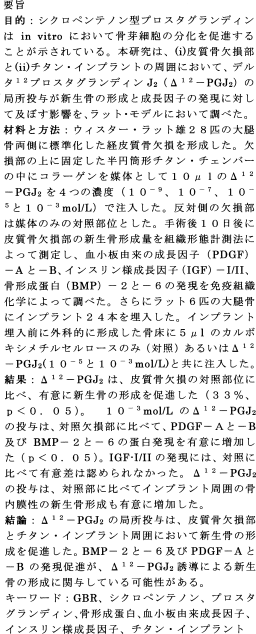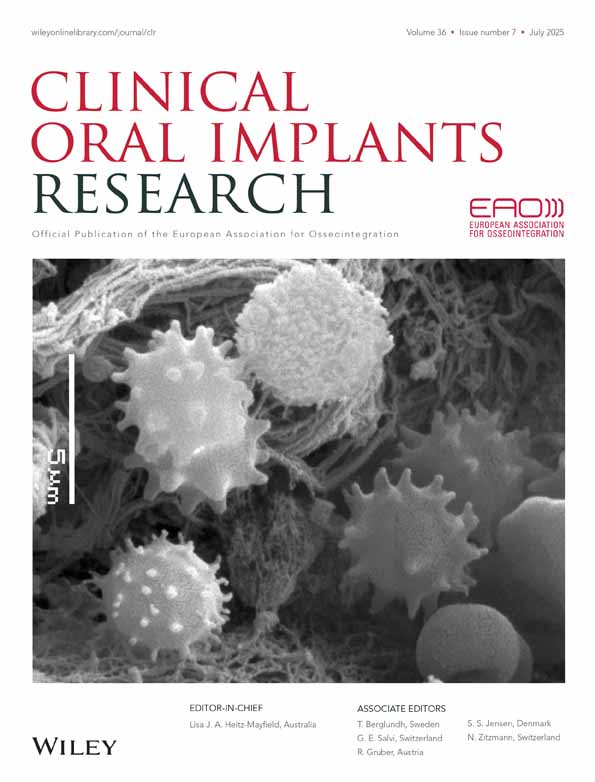Effects of Δ12-prostaglandin J2 on bone regeneration and growth factor expression in rats
Abstract
enObjectives: Cyclopentenone prostaglandins have been shown to promote osteoblast differentiation in vitro. The aim of this study was to examine in a rat model the effects of local delivery of Δ12-prostaglandin J2 (Δ12-PGJ2) on new bone formation and growth factor expression in (i) cortical defects and (ii) around titanium implants.
Material and methods: Standardized transcortical defects were prepared bilaterally in the femur of 28 male Wistar rats. Ten microliters of Δ12-PGJ2 at 4 concentrations (10−9, 10−7, 10−5 and 10−3 mol/l) in a collagen vehicle were delivered inside a half-cylindrical titanium chamber fixed over the defect. Contralateral defects served as vehicle controls. Ten days after surgery, the amount of new bone formation in the cortical defect area was determined by histomorphometry and expression of platelet-derived growth factor (PDGF)-A and -B, insulin-like growth factor (IGF)-I/II, bone morphogenetic protein (BMP)-2 and -6 was examined by immunohistochemistry. In an additional six rats, 24 titanium implants were inserted into the femur. Five microliters of carboxymethylcellulose alone (control) or with Δ12-PGJ2 (10−5 and 10−3 mol/l) were delivered into surgically prepared beds prior to implant installation.
Results: Δ12-PGJ2 (10−5 and 10−3 mol/l) significantly enhanced new bone formation (33%, P<0.05) compared with control cortical defects. Delivery of Δ12-PGJ2 at 10−3 mol/l significantly increased PDGF-A and -B and BMP-2 and -6 protein expression (P<0.05) compared with control defects. No significant difference was found in IGF-I/II expression compared with controls. Administration of Δ12-PGJ2 also significantly increased endosteal new bone formation around implants compared with controls.
Conclusion: Local delivery of Δ12-PGJ2 promoted new bone formation in the cortical defect area and around titanium implants. Enhanced expression of BMP-2 and -6 as well as PDGF-A and -B may be involved in Δ12-PGJ2-induced new bone formation.
Résumé
frLes prostaglandines cyclopentenones ont prouvé leur efficacité dans la différenciation des ostéoblastes in vitro. Le but de cette étude a été d'examiner dans le modèle du rat les effets de la libération locale de prostaglandines J2 (Δ12-PGJ2) sur la néoformation osseuse et l'expression de facteurs de croissance dans (1) les lésions corticales et (2) autour des implants en titane. Des lésions transcorticales standardisées ont été préparées bilatéralement dans le fémur de 28 rats mâles Wistar. Dix μl de Δ12-PGJ2à quatre concentrations (10−9, 10−7, 10−5 et 10−3 mol/l) dans un véhicule collagène ont été placés à l'intérieur d'une chambre en titane demi-cylindrique fixée sur la lésion. Les lésions contralatérales ont servi de contrôle. Dix jours après la chirurgie, la quantité d'os néoformé dans la lésion corticale a été déterminée par histomorphométrie et l'expression du facteur de croissance dérivé des plaquettes (PDGF)-A et -B, le facteur de croissance ressemblant à l'insuline (IGF)-I/II, la protéine morphogénétique osseuse (BMP)-2 et -6 a été examinée par immunohistochimie. Chez six rats supplémentaires, 24 implants en titane ont été insérés dans le fémur. Cinq μl de carboxyméthylcellulose seul (contrôle) ou avec Δ12-PGJ2 (10−5 et 10−3 mol/l) ont été placés dans les lits préparés chirurgicalement avant l'insertion implantaire. Le Δ12-PGJ2 (10−5 et 10−3 mol/l) augmentait la néoformation osseuse (33%, P<0.05) comparé aux lésions corticales contrôles. Le placement de Δ12-PGJ2à 10−3 mol/l augmentait significativement l'expression BMP-2 et -6 et PDGF-A et B (P<0.05) comparée aux lésions contrôles. Aucune différence n'a été trouvée dans l'expression IGF-I/II comparée aux contrôles. L'administration de Δ12-PGJ2 augmente également significativement la néformation osseuse endostéale autour des implants comparée aux contrôles. Le placement local de Δ12-PGJ2 améliorait la néoformation osseuse dans la lésion corticale et autour des implants dentaires. Une augmentation de l'expression de BMP-2 et -6 ainsi que de PDGF-A et -B peut être impliquée dans la néoformation osseuse induite par Δ12-PGJ2.
Zusammenfassung
deZiel: Man hat gezeigt, dass Cyclopentenon Prostaglandine in vitro die Differenzierung von Osteoblasten beschleunigen können. Das Ziel dieser Studie war nun, im Rattenmodell den Einfluss einer lokalen Verabreichung von Δ12-Prostaglandin J2 (Δ12-PGJ2) auf die Neubildung von Knochen und die Ausscheidung von Wachstumsfaktoren in (i) kortikalen Defekten und (ii) um Titanimplantate zu untersuchen.
Material und Methoden: In beide Oberschenkelknochen von 28 männlichen Wistarratten präparierte man standartisierte transkortikale Defekte. Das Trägermaterial Kollagen diente zur Verabreichung von je 10 μl Δ12-PGJ2 in vier verschiedenen Konzentrationen (10−9, 10−7, 10−5 und 10−3 mol/l) in eine halbzylindrische Titankammer, die dann über den Defekt montiert wurde. Die kontralaterale Seite diente, gefüllt mit demselben Trägermaterial, als Kontrolle. Zehn Tage nach dem chirurgischen Eingriff bestimmte man einerseits mit der Histomorphometrie die Menge des neu gebildeten Knochens in den kortikalen Defekten und andererseits mit der Immunohistochemie die Ausscheideraten des aus den Plättchen stammenden Wachstumsfaktors-A und -B (PDGF-A/-B), des insulinähnlichen Wachstumsfaktors-I/II (IGF-I/II) und des morphogenetischen Knochenproteins-2 und -6 (BMP-2/-6). Bei 6 weiteren Ratten implantierte man 24 Titanimplantate in den Femur. Vor dem Eindrehen der Implantate injizierte man in die chirurgisch vorbereiteten Implantatbette entweder 5 μl reine (Kontrolle) oder mit Δ12-PGJ2 (10−5 und 10−3 mol/l) angereicherte Carboxymethylcellulose-Lösung.
Resultate: Δ12-PGJ2 (10−5 und 10−3 mol/l) beschleunigte, verglichen mit den kortikalen Kontrolldefekten, die Knochenneubildung signifikant (33%, P<0.05). Bei einer Anwendung von Δ12-PGJ2 in der Konzentration von 10−3 mol/l nahm die Ausscheidung der Proteine PDGF-A und -B sowie BMP-2 und -6 verglichen mit den Kontrolldefekten signifikant zu (P<0.05). Bei der Ausscheidung von IGF-I/II hingegen fand man verglichen mit den Kontrollen keine signifikanten Unterschiede. Auch signifikant gesteigert durch die Verabreichung von Δ12-PGJ2 verglichen mit den Kontrollen war das enossale Knochenwachstum um die eingesetzten Implantate.
Zusammenfassung: Eine lokale Verabreichung von Δ12-PGJ2 förderte die Knochenneubildung in kortikalen Defekten und um Titanimplantate. Die gesteigerte Ausscheidung von BMP-2 und -6 sowie von PDGF-A und -B könnte einen Zusammenhang mit der durch Δ12-PGJ2 induzierten Knochenneubildung haben.
Resumen
esObjetivos: Se ha demostrado que las prostaglandinas ciclopentenonas promueven la diferenciación osteoblástica in vitro. La intención de este estudio fue examinar, en un modelo de rata, el efecto de la liberación local d6e6Δ12-prostaglandina J2 (Δ12-PGJ2) sobre la formación de nuevo hueso y sobre la expresión en (i) defectos corticales y (ii) alrededor de implantes de titanio.
Material y Métodos: Se prepararon defectos transcorticales estandarizados bilateralmente en el fémur de 28 ratas Wistar macho. Se suministraron diez μl de Δ12-PGJ2 en 4 concentraciones (10−9, 10−7, 10−5 year 10−3 mol/l) en un vehiculo de colágeno en el interior de unas cámaras medio cilíndricas de titanio fijadas sobre el defecto. Los defectos contralaterales sirvieron de control. Diez días tras la cirugía, se determinó la cantidad de formación de nuevo hueso en el área del defecto cortical por histomorfometría y se examinó por inmunohistoquímica la expresión del factor de crecimiento derivado de las plaquetas (PDGF)-A y -B, el factor de crecimiento tipo insulina (IGF)-I/II, la proteína morfogenética humana (BMP)-2 year -6. En 6 ratas adicionales, se insertaron implantes de titanio en el fémur. Se suministraron cinco μl de carboximetilcelulosa sola (control) o con Δ12-PGJ2 (10−5 year 10−3 mol/l) en los lechos preparados quir úrgicamente antes de la instalación de los implantes.
Resultados: El Δ12-PGJ2 (10−5 year 10−3 mol/l) aumentó significativamente la formación de hueso nuevo (33%, P<0.05) comparado con los defectos corticales de control. El suministro de Δ12-PGJ2 a 10−3 mol/l aumentó significativamente el PDGF-A y–B y la expresión de las proteínas BMP-2 y -6 (P<0.05) comparados con los defectos de control. No se hallaron diferencias significativas en la expresión de IGF-I/II comparada con los controles. La administración de Δ12-PGJ2 también aumentó significativamente la formación nuevo hueso endostal alrededor de los implantes en comparación con los controles.
Conclusión: La liberación local de Δ12-PGJ2 promovió la formación de nuevo hueso en el área del defecto óseo cortical y alrededor de los implantes de titanio. Una expresión aumentada de BMP-2 y -6 al igual que el PDGF-A y -B pueden estar involucrados en la formación de nuevo hueso inducido por Δ12-PGJ2.





